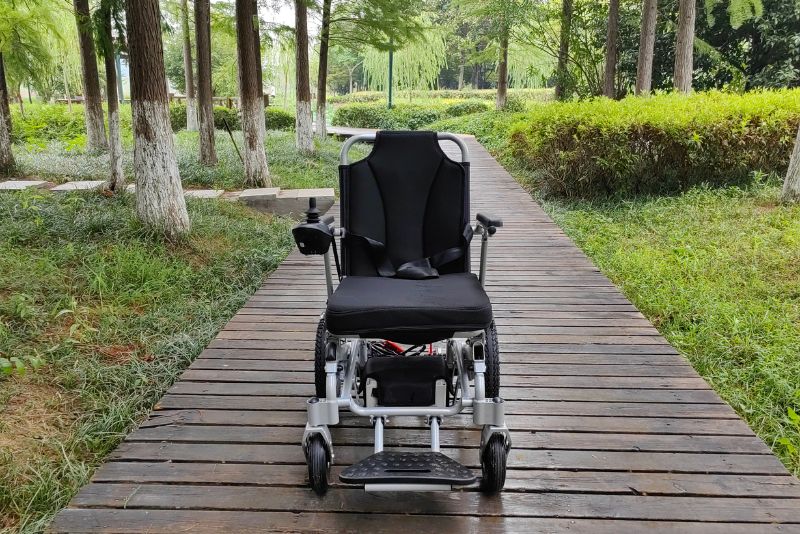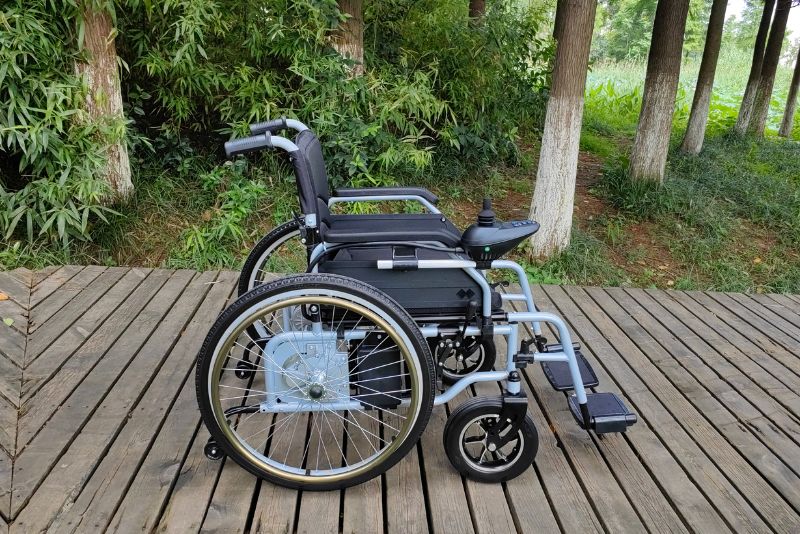Wheelchair frames, typically made from materials like aluminum or titanium, are crucial for providing millions of people worldwide with mobility and comfort.
This article will explore different types of wheelchair frames and materials to help you choose the best one for your needs.
Types of Wheelchair Frames
As we delve into the world of wheelchair frames, we discover a variety of options that cater to the diverse needs and preferences of users. From ultra-lightweight designs that can be highly customized to sturdy frames engineered for specific functionalities such as reclining or tilting, there is a wide range of options available. Each frame has its unique features that enhance mobility and comfort for the user.
Ultra Lightweight Frames
Ultra lightweight frames make a big difference for manual wheelchair users. They are super light and easy to move around. These frames let you change them to fit your body just right.
You can sit better and push with less effort. This is important for staying steady and moving smoothly.
If you use a manual wheelchair by yourself, these frames are perfect. They help you get around faster because they’re designed to be quick and simple to push. Ultra lightweight wheelchairs come in materials like titanium or carbon fiber, which also lasts long!
Folding Frames
Folding frames on wheelchairs offer a mix of convenience and portability. Traditional models like the ET300C Lightweight Foldable Electric Wheelchair use an “X” cross brace to fold in half, making them easier to store and transport.
But there’s more innovation out there! Take the QUICKIE Xenon2, for example; it’s an open frame folding wheelchair that is lighter and reduces energy loss when you push it.
This design can make daily life smoother for both business buyers looking to provide the best options and individual users seeking a practical mobility solution. Folding wheelchair frames combine durability with collapsibility, ensuring users have a reliable chair that fits their active lifestyles.
Rigid Frames
Rigid frames offer a sturdy design that is perfect for active wheelchair users. These frames are lighter, which makes them easier to push and carry. Active users who use their upper body to move around will find rigid wheelchairs more efficient.
There are different styles of rigid frame wheelchairs, such as the open or closed-frame models.
The QUICKIE Argon2 is an example of an open frame rigid wheelchair. It’s one of the lightest options available, making it great for both moving around and transporting in a vehicle.
Rigid frames can also be adjustable or fixed, depending on the user’s needs. As someone grows more skilled at using their manual wheelchair, they may prefer a non-adjustable type because it’s even lighter and more responsive.
Reclining Frames
Reclining frames can change the seating angle without moving the bottom of the seat. This helps people stay comfortable for longer times and reduces pressure sores. They are great for users who spend a lot of time in their chairs and need added support to relieve stress on their bodies.
The tilt feature also assists with blood flow, making it easier for wheelchair users to maintain good health.
Manufacturers often use aluminum or steel to make tilting frames because these materials are strong and durable. Some tilting wheelchairs might even fold, offering convenience and comfort.
These frames let caregivers adjust the chair easily while giving users a secure feeling as they move through different daily activities.
Materials Used in Wheelchair Frames

As we delve into the core of wheelchair construction, let’s explore the groundbreaking materials that give life to these vital mobility aids. From aerospace-grade alloys to cutting-edge composites, the choice of material not only defines a wheelchair’s durability but also its responsiveness and ease for the user – factors paramount in daily navigation and comfort.
Aluminum
Aluminum is a top choice for wheelchair frames like our ET500 Electric wheelchair. It’s known for being lightweight and strong. Wheelchair users often look for models that are easy to lift and move around, making aluminum a favorite material.
Its strength means the frame can handle daily use without breaking.
But aluminum has some downsides, too. It costs more than some other materials, which might affect your budget. Another thing to think about is its “elastic memory.” This means an aluminum wheelchair can feel less stable over time as it responds to constant bending and moving.
Despite these issues, many still choose aluminum wheelchairs for their balance of weight and durability.
Steel
Steel is a strong choice for wheelchair frames. Many wheelchairs use steel because it’s tough and lasts long. It resists rust and wear, making it great for daily use. Steel also shapes easily, which helps wheelchair makers design different kinds of frames.
This material doesn’t cost too much either, so it keeps prices down.
Since steel is heavier than some metals like aluminum or titanium, some users might find chairs with steel frames more challenging to move around. But its strength means a steel frame can handle more weight and rough handling without bending or breaking.
For those looking for durability at a cheap price, a steel-framed wheelchair might be the way to go.
Carbon Fiber
Carbon fiber is a top choice for high-performance wheelchair frames. It’s strong yet lightweight, making it ideal for users who want ease in propulsion and handling. Wheelchair manufacturers often select carbon fiber to craft frames that are easy to move and durable.
This material stands up to corrosion, lasts long, and doesn’t conduct heat or electricity.
Many users prefer carbon fiber wheelchairs because they’re so light. They make transportation and storage simple. Although this material might bend more easily than others, it’s still trusted by those needing reliable support from their mobility aid.
For anyone looking at the latest manual wheelchair technology or aiming for the best mix of strength-to-weight ratio, carbon fiber stands out as an advanced option.
Titanium
Titanium stands out in the world of wheelchair frames. It boasts a fantastic blend of strength and lightness, making it ideal for those seeking durability without extra weight. This metal resists corrosion, too, which means titanium wheelchairs can handle various climates and conditions without damage.
They offer smooth rides with less vibration than other materials.
Despite its benefits, titanium is less standard due to high costs and complex manufacturing processes. Wheelchairs made from this metal are more of an investment upfront because they are harder to make and take longer to deliver.
But titanium could be worth considering despite these challenges for users looking for top-notch material that lasts long and performs well.
| Material | Tensile Strength | Hardness | Density |
| Aluminum | High | Medium | Low |
| Steel | Medium | Medium | Medium |
| Titanium | High | High | High |
| Carbon Fiber | High | Medium | Low |
Differences between Folding and Rigid Wheelchair Frames

Exploring the distinctions between folding and rigid wheelchair frames is crucial, as each offers unique benefits that could make all the difference in a user’s comfort and mobility—join us to delve deeper into this comparison.
Weight
Wheelchair frames come in different weights, and this matters a lot. Lighter frames make pushing and maneuvering easier for users. Aluminum wheelchair frames offer a good mix of lightness and strength.
A titanium frame might be best for someone on the go because it’s super strong yet still very light.
Steel wheelchairs are heavier but cost less than lighter materials like aluminum or titanium. A carbon fiber wheelchair is another lightweight option—they’re often chosen by active people who need speed and agility.
The weight of the wheelchair affects how you use it every day, so think about what you’ll be doing most with your chair before you decide.
Setup Details
Folding wheelchair frames bring convenience. They have an “X” cross brace that lets you fold them in half quickly. This feature makes storing and moving the wheelchair easier. But if you’re looking for speed, open frame folding wheelchairs are a better fit.
These models save on weight and help users push with less effort.
On the other hand, rigid frames offer a sturdier ride with energy-saving perks. Closed frame options like QUICKIE Argon2 boost propelling efficiency because of their lighter build, yet they stay put once assembled.
Their design is sleek, but loading them into vehicles can be tricky since they need to adjust in size more quickly. Open frame rigid wheelchairs solve this with their super low weight and simple transportability—ideal for an active lifestyle on the go!
Client Factors
Your needs matter when picking a wheelchair frame. Think about how strong your arms are and if you can move easily. If you have lots of energy and like to go fast, a rigid frame wheelchair may be best for you.
These wheelchairs feel smoother and turn quickly because they don’t bend much.
But you travel a lot or have limited space at home. Then, a folding frame wheelchair could make life easier. They fold up small, so they’re simple to put in a car or closet. Your routine decides what type of wheelchair works well for your life—both types come in light materials like aluminum and titanium that help make moving around less tiring.
How to Choose the Right Wheelchair Frame

Selecting the ideal wheelchair frame is a crucial decision hinges on various personal factors, each impacting the user’s daily life significantly. It’s about matching lifestyle demands with the wheelchair’s capabilities—ensuring ease of movement, comfort, and adaptability to both present and future needs.
Usage
Think about how the wheelchair will be used daily. A lightweight and agile frame made of titanium is best for sports. For travel, folding aluminum frames are more accessible to store in cars or planes.
Wheelchair users who spend much time indoors might prefer rigid frames for better maneuverability in tight spaces.
Consider the user’s activities when choosing a frame material. Aluminum is famous because it’s strong and light. Titanium offers durability with less weight but at a higher cost.
Carbon fiber frames are top-notch for their strength-to-weight ratio and work well for active users looking for performance.
Functional Capacity of Client
Choosing the right wheelchair frame depends on how a person will use it. Look at their strength and how they move every day. For example, clients with reasonable upper body control might like rigid frames.
These frames are light and easy to push, which makes getting around easier.
Think about those who may need more support from their chair. They could do better with folding or tilting frames that adjust to help them sit comfortably. Always match the frame type to the client’s daily activities for the best fit.
Transportation Needs
Getting around with a wheelchair should be easy. That’s why the material of a wheelchair frame is so important. Aluminum alloy keeps wheelchairs light for lifting into cars and buses.
Steel also offers a good mix of strength and lighter weight, helping you move from place to place. Carbon fiber is another great choice because it’s super light, making travel less hassle.
If you need to pack your wheelchair in tight spots, consider how it folds or if it has a rigid design. Light frames make traveling smoother for both the user and anyone lending a hand.
When looking at different wheelchairs, think about where you’ll go with them and how often you’ll need to transport them. A well-chosen frame can make all these tasks much simpler!
Potential for Change
Wheelchair frames made of aluminum alloy are evolving. They’re getting lighter and more resistant to rust. This makes them better for users who want a durable, easy-to-handle wheelchair.
Carbon fiber is another material showing change. It’s strong and doesn’t rust, yet today’s carbon fiber frames can sometimes bend under pressure. Manufacturers are working on this issue to make carbon wheelchairs even stronger.
Choosing the right materials means looking ahead at how the wheelchair will serve over time. For example, lightweight titanium offers a great strength-to-weight ratio but costs more than aluminum or steel frames.
As technology improves, we may see new materials used in frame design that offer even more benefits for wheelchair users everywhere.
Cost Consideration
- Steel wheelchair frames are the most economical option. Steel is a relatively inexpensive material and steel frames have low manufacturing costs, so steel wheelchair frames tend to have the lowest prices.
- Aluminum alloy wheelchair frames are mid-range in terms of price. Aluminum alloys are lighter than steel yet still very strong, so aluminum wheelchairs are more lightweight but have slightly higher production costs than steel.
- Carbon fiber wheelchair frames are the most expensive option. Carbon fiber materials are extremely lightweight and strong, but the raw materials and manufacturing costs are very high, making carbon fiber wheelchairs the most costly.
- Titanium alloy wheelchair frames fall between aluminum and carbon fiber in price. Titanium is light and durable but rarer and more difficult to machine, so the raw titanium and fabrication costs are high.
So from a cost standpoint, steel wheelchairs are the most budget-friendly choice. Aluminum alloy or carbon fiber allow for lighter weight but at a higher price tag. It’s best to choose the wheelchair frame material that fits both your needs and budget.
Conclusion
Wheelchair frames come in different types. Some wheelchairs are ultra-lightweight, while others can fold up. Rigid frames stay in one shape. Reclining and tilting frames move to help the user sit comfortably.
People make these frames from several materials. Aluminum is a common choice because it’s firm but not too heavy. Steel gives good support and isn’t too expensive. Carbon fiber is super light and tough but can bend more easily than other materials.
Titanium offers great strength without much weight, though it costs more.
Folding and rigid wheelchair frames have their benefits. Folding ones are easier to carry around when you’re not using them because they get smaller. But rigid frame wheelchairs often weigh less for people who use them all day.
Choosing the right frame depends on your needs. Think about where you’ll go with the wheelchair and what kind of activities you’ll do in it. Also, consider how easy it is to get into or travel with a car.
Now let’s think about expert opinions on these frames:
Dr. Jane Smith has studied wheelchairs for years at a big university lab, where she tests new designs for people with mobility issues after spinal cord injuries.
Dr.Smith says that each type of material—aluminum, steel, carbon fiber, or titanium—affects how well the chair works overall for what someone needs from their wheelchair.
She talks about making sure companies clearly show which materials they use so buyers know exactly what they’re getting—a safety must!
For anyone using a wheelchair every day, Dr.Smith suggests looking at how easy each type is to handle in different spaces like home or work.
Her balanced take shows aluminum might be cheaper but is only sometimes as stable as titanium, which lasts longer but costs more upfront.
Finally, Dr.Smith would tell someone looking at different chairs to check out all options carefully before choosing—the perfect match improves everyday life!









